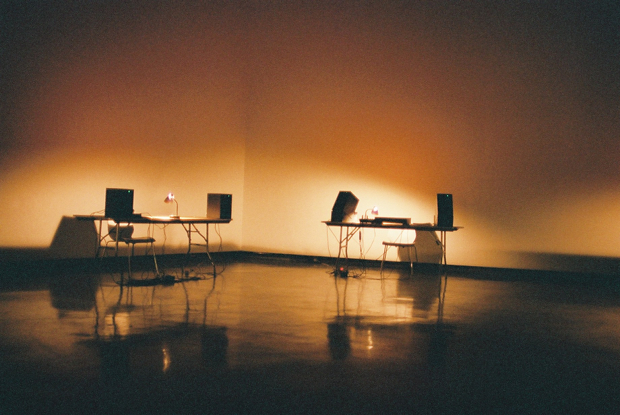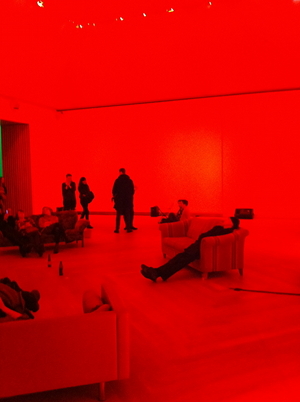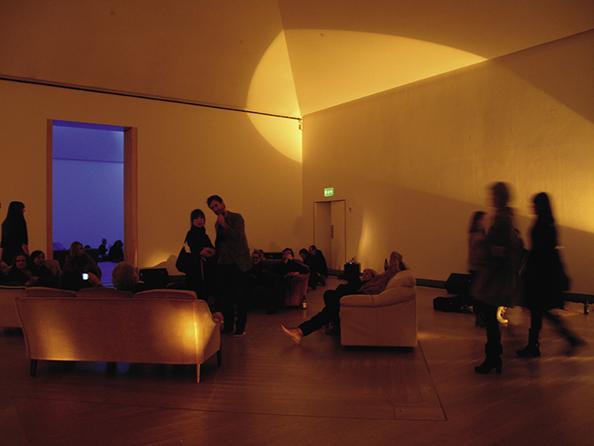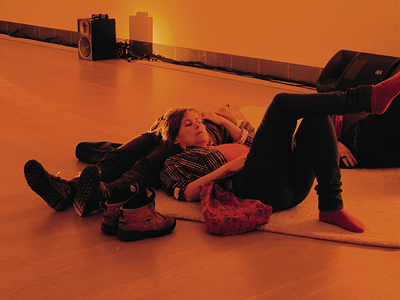In February 2012 Moderna Museet in Stockholm hosted the eighth version of freq_out, a sound installation which may well be the biggest separate sound work ever to be presented at an art museum. The first version was developed during a workshop in 2003 at Charlottenborg in Copenhagen, under the heading Disturbances (Sound as Space Creator). Other versions have since been presented at art and music festivals such as Nuit Blanche, Sonambiente, Happy New Ears and Ultima. The only-ever outdoor version took place in Thailand, in the garden of the CMU Art Museum, under the direction of the Land Foundation in collaboration with Building Transmissions from Belgium.
freq_out: rhizome and drone; the micro/macro aggregate
John Cage's understanding of listening – in which silence is never silent – is an important part of how freq_out is experienced. However, the work is not founded so much on Cage's ideas as on the connection between Le Corbusier, Iannis Xenakis and Edgard Varèse and their collaboration on the Philips Pavilion, which was designed for Expo 58 in Brussels. As collaborations go, this wasn't much of a «joint venture», since Le Corbusier took all the credit without clarifying that Xenakis had done most of the work on the concept and the architecture. Xenakis moreover wrote the introductory part of the electronic piece of music whose other part was the Poème Electronique, composed by Varèse.
In any case, the final product of this work is an interesting symbiosis of architecture, art and music, and something I've had in mind while freq_out was being constructed.
Another natural point of entry to freq_out is electronic and concrete music, whose origins go back to the 1940s and 50s. This type of music has furthermore grown exponentially over the last twenty years, with the spread of the internet and the development of software.
In addition to all this there are three crucial terms that constitute the foundation of freq_out. The first two of these are rhizome and drone. The term drone featured originally in both military and biological contexts. It denotes a low, unchanging sound. This definition of drone is linked to Europe and New York in the 1960s and to the group of musicians in the Fluxus network: most prominently the composers LaMonte Young, Terry Riley and Yoko Ono.[i] They held concerts that consisted of the artists playing or reciting one or several instrumental or guttural tones, often of extremely long duration – a form of auditory concentration and meditation in the spirit of the mantra in Zen Buddhism and other Indian religions. In later years other artists, including Eliane Radigue, Robert Fripp, Brian Eno, Christian Fennez, the Hafler Trio, Soviet•France, Jim O'Rourke, Christina Kubisch, Glenn Branca, Sunn(O))) and Hildur Gudnadottir have been linked to the term.
Gilles Deleuze's and Felix Guattari's thoughts about the rhizome have been well known for more than twenty years, not just in postmodern philosophy but also in music. In the introduction to Deleuze's and Guattari's text about the term we read: «To reach, not the point where one no longer says I, but the point where it is no longer of any importance whether one says I. We are no longer ourselves. Each will know his own. We have been aided, inspired, multiplied. » [ii]
In nature a rhizome is an underground part of a plant stem; in the context of freq_out the term can be likened to an endless stalk or tree trunk with neither roots nor crown. The joined-up sound work has neither beginning nor end, being instead in constant flow, like a river of interwoven sound elements meandering and twisting, while at the same time a multitude of in- and outflows of sound billow back and forth. In that way a gently pulsating and dynamic rhizome is created whose source is the participating artists and whose outflow is the audience that happens to be in the space.
freq_out's third term is perhaps the most complex one, yet the most useful beyond the sphere of the artwork itself. Here freq_out can be seen as a model for a micro-macro system. In R. Buckminster Fuller's words: «The Universe is the aggregate of all of humanity's consciously-apprehended and communicated experience with the nonsimultaneous, nonidentical, and only partially overlapping, always complementary, weighable and unweighable, ever omni-transforming, event sequences.» [iii]
In accordance with this, the model can function as an overview of a whole held together by smaller parts and in which these parts individually form other wholes, in turn held together by smaller parts. As a model, freq_out can function as an entire, movable galaxy in which each of the twelve parts is a solar system in itself. Additionally, the work itself can be seen as one of these solar systems in which twelve planets are looping around their star. Or else this model is like a planet divided into twelve units – twelve units that maintain the form and function of the planet. Thus we can gradually move down to the micro level, where freq_out is like the nucleus of an atom with neutrons and protons circling it, rotating and interacting. The fact that the work has a meditative effect and induces in the audience a feeling of quiet, contemplative calm shows that in a strange way, this model works – not just for the audience but also for the participating artists, in the relationship between their individual works and in the community they constitute.
freq_out: composition
For freq_out, the invited artists have been allotted frequency intervals within the frequency range audible to humans. Artist number one has been allotted 0 – 25 Hz, number two 25 – 65 Hz, and so on. Over a period of four days, the artists' task is to compose one sound work each. The work must not contain any sounds that exceed the allotted frequency interval, but may be of any length and is to be played back as a loop. Any sounds may be used. Most often the artists use sounds from the geographic location they are in – most recently in Stockholm. They might be concrete sounds from the museum, the city, the country, or sounds that in one way or another reflect the location. These sounds are processed analogically or digitally in the way the artist chooses. The work consists of 12 smaller works joined together into a whole: a kind of collage, to use an older term. Thus, when the works are played back they are all played at once, through twelve different sounds systems. At Moderna Museet we used twice that capacity: 48 loudspeakers via 24 sound channels. Since the sound frequencies are different, there are no collisions between individual sounds, only interference – audio complements – which arise as sound phenomena in the spaces. This configuration of frequencies has a great deal in common with the instrumental content of a large symphony orchestra, from the double bass to the piccolo flute.
Each artist works individually, without anyone else's involvement, but all those involved must be able to accept what the others produce – including what I do. There is a parallel here with the free jazz developed by European and American musicians during the 1970s, e.g. Peter Brötzmann and the Art Ensemble of Chicago. freq_out is a collective work crafted by very self-contained individuals. Ego must be finely balanced against group, and in today's ego-centred society – which includes the art world – this is always a risky business. The ego must be questioned.
 |
| freq_out 2 at Henie-Onstad Center, Oslo photo © Finnbogi Petursson |
|
freq_out: Stockholm 2012
It seems perfectly appropriate that it was Moderna Museet which ended up showing the work on a grand scale. Ever since it opened, the museum has demonstrated an interest in and possessed knowledge about sound as an important constituent of art. It understood the connection between John Cage, Robert Rauschenberg and Merce Cunningham, and it has contributed to multidisciplinary artists such as Öyvind Fahlström, Åke Hodell and, most recently, Sten Hanson and Eija-Liisa Ahtila being able to show their work.
For myself, I understood the museum's interest in combinations of image, text and dramatic art when I staged Michel Journiac's Rituel pour un corps absent in the old cinema during the performance art festival «20 Live Projects» in 1981.[iv] The notion that information perceived with the eyes and information perceived with the ears use the same reference and processing system in the brain has been fundamental for the museum's activities throughout its fifty-four years of existence.
freq_out is a work that uses sound as its only component part. No visual artworks are included in its construction. Which doesn't mean that the spaces used have been in complete darkness. In Copenhagen and Chiang Mai ambient daylight was used, in Berlin and Oslo simple light bulbs, and in Kortrijk and Paris more intricate illumination systems with red light. At Moderna Museet the rooms were lit with the seven colours of the rainbow, since there were seven separate rooms to use. And naturally the rooms functioned in different ways, since the colours with their different characteristics affect the human psyche in different ways.
 |
| freq_out 8 at Moderna Museet, Stockholm photo© CM von Hausswolff |
|
 |
| freq_out 9 at Stedelijk Museum, Amsterdam photo© CM von Hausswolff |
|
|
Four or five soft sofas were placed in the rooms for the audience to sink comfortably into, as well as quite a few carpets on the otherwise rather hard floor. In the two smaller rooms, bars were also set up and offered light dishes, wine, beer etc. In the mornings a simple breakfast was also served.
During the 48 hours, then, the audience – young and old – could come and go as they pleased. They could meet with others; they could stand, sit or lie down and talk to each other. They could become absorbed by the sonic components of the work, singly or together; fall asleep and awake again, walk into another room with another colour, another sound mix, and have a different experience.
 |
| freq_out 8 at Moderna Museum, Stockholm. Photo: © Maia Urstad |
|
freq_out: artists
Almost all of the thirteen artists invited to
participate in freq_out 8 have been involved since the
first installation, in Copenhagen. It has become the custom that
if someone is unable to participate, a new artist is invited.
The show at Moderna Museet added the Swedish image and sound artist
Christine Ödlund since BJNilsen was unable to attend. Finnbogi
Petursson from Iceland, Jacob Kirkegaard from Denmark and Jana
Winderen and Maia Urstad from Norway are all well known for their
sound installations. In 2011 Winderen won the Golden Nica at «Ars
Electronica» in Linz for her audio-oceanographic works. The Finnish
duo Tommi Grönlund and Petteri Nisunen both exhibited works at
and curated the Nordic Pavilion at Venice in 2001. They have made
themselves a name with their light, sound and architecture-based
installations. Austrian Franz Pomassl, professor at the arts academy
in Vienna, is part of the same world. Participants from the world
of traditional music included EAM composer PerMagnus Lindborg
and Australian-American J.G. Thirlwell, recognised for his more
than thirty years in the regions of rock with his one-man band,
Foetus, and for having written music for the Kronos Quartet. Kent
Tankred is seen, in Sweden as well as in other countries, as half
of the Guds Söner performance duo. American Brandon LaBelle works
with conceptual and relational sound works, and is also the author
of a number of books on sound art, e.g. Background Noise: Perspectives
on Sound and Acoustic Territories: Sound Culture and Everyday
Life. The only non-artist in the context is Mike Harding, who
is a producer and runs the influential British record and culture
company TOUCH, with second labels Ash International and OR.
All the participating artists use different methods and media in their work: music, architecture, film, science, performance, installation etc. On paper it may seem as if many of them don't have very much in common, but the system that constitutes freq_out shows something else.
My function, besides having conceived this work, is to hover in the grey zone between artist and curator. I'm the one who makes the final mix of all the sounds in the rooms, and I decide on the placement of loudspeakers and determine their various frequency ranges, thus imposing my will and my stamp on the work. Without the respect, reverence, consideration and acceptance of all the others involved this would not be possible.
 |
| freq_out 8 at Moderna Museum, Stockholm. Photo: © Sissel Lillebostad |
|
 |
| freq_out 8 at Moderna Museum, Stockholm. Photo: © Maia Urstad |
|
|
|

![]() where no other claim is indicated.
where no other claim is indicated.
![]() where no other claim is indicated.
where no other claim is indicated.